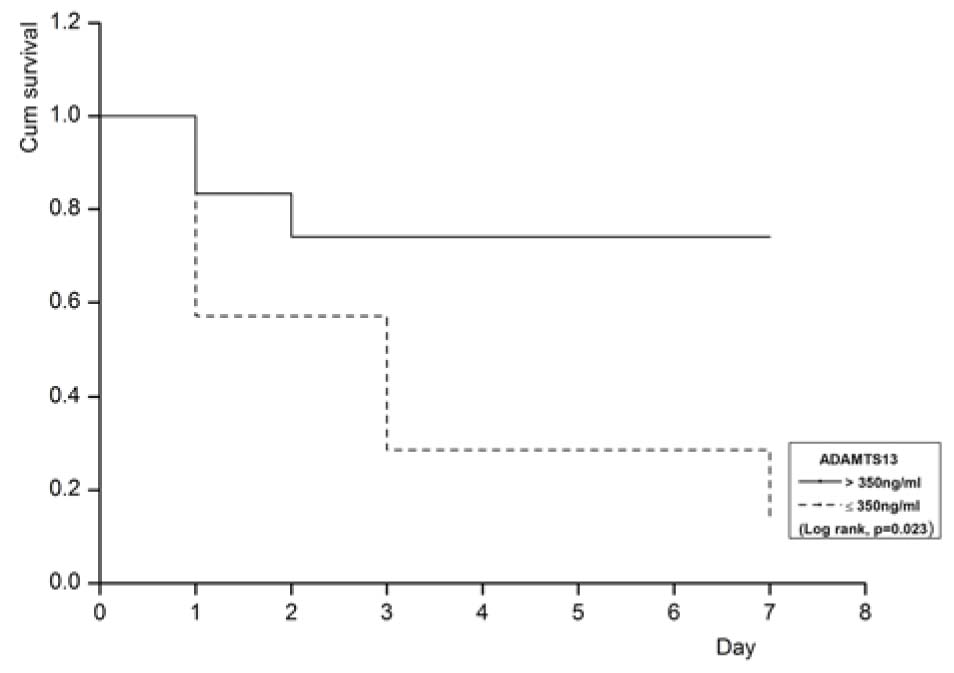Infect Chemother.
2009 Apr;41(2):78-81. 10.3947/ic.2009.41.2.78.
Clinical Significance of von Willebrand Factor-Cleaving Protease (ADAMTS13) Deficiency in Patients with Sepsis-Induced Disseminated Intravascular Coagulation
- Affiliations
-
- 1Department of Internal Medicine, Yonsei University Wonju College of Medicine, Wonju, Korea.
- 2Department of Laboratory, Medicine, Hanaro Medical Foundation, Seoul, Korea. lee423619@hanmail.net
- 3Department of Laboratory Medicine, Yonsei University College of Medicine, Seoul, Korea.
- 4Department of Anesthesiology and Pain Medicine, Konyang University College of Medicine, Daejeon, Korea.
- KMID: 2170254
- DOI: http://doi.org/10.3947/ic.2009.41.2.78
Abstract
- BACKGROUND
Deficiency of von Willebrand factor-cleaving protease, a disintegrin-like and metalloprotease with thrombospondin type 1 motif 13 (ADAMTS13), is thought to be responsible for platelet aggregation and microthrombi formation, which in turn cause typical thrombotic microangiopathies. This deficiency is found in patients with thrombocytopenia-associated multiple organ failure such as thrombocytopenic purpura and disseminated intravascular coagulation (DIC). We evaluated the clinical significance of ADAMTS13 deficiency in patients with sepsis-induced DIC. MATERIALS AND METHODS: Nineteen patients with sepsis-induced DIC were enrolled. ADAMTS13 antigen levels were determined by Enzyme-Linked Immunosorbent Assay (ELISA) and activity levels were measured by fluorescence resonance energy transfer assay. Patients were categorized into two groups according to ADAMTS13 antigen level: less than 350 ng/mL or above. Clinical characteristics and survival were compared between the two groups. RESULTS: ADAMTS13 antigen level was less than 350 ng/mL in 7 patients and was above 350 ng/mL in 12 patients. There were no significant differences between the groups for age, sex, severity of illness, and other clinical characteristics. In patients with ADAMTS13 antigen level less than 350 ng/mL, in-hospital mortality was much higher (100% versus 25%, P=0.003) and 7-day survival was much shorter (P=0.023). CONCLUSION: Deficiency of ADAMTS13 could be thought to be associated with unfavorable outcome in patients with sepsis-induced DIC.
MeSH Terms
Figure
Reference
-
1. Moake JL. Thrombotic microangiopathies. N Engl J Med. 2002. 347:589–600.
Article2. Furlan M, Robles R, Solenthaler M, Lämmle B. Acquired deficiency of von Willebrand factor-cleaving protease in a patient with thrombotic thrombocytopenic purpura. Blood. 1998. 91:2839–2846.
Article3. Mannucci PM, Canciani MT, Forza I, Lussana F, Lattuada A, Rossi E. Changes in health and disease of the metalloprotease that cleaves von Willebrand factor. Blood. 2001. 98:2730–2735.
Article4. Loof AH, van Vliet HH, Kappers-Klunne MC. Low activity of von Willebrand factor-cleaving protease is not restricted to patients suffering from thrombotic thrombocytopenic purpura. Br J Haematol. 2001. 112:1087–1088.
Article5. Moore JC, Hayward CP, Warkentin TE, Kelton JG. Decreased von Willebrand factor protease activity associated with thrombocytopenic disorders. Blood. 2001. 98:1842–1846.
Article6. Nguyen TC, Carcillo JA. Bench-to-bedside review: thrombocytopenia-associated multiple organ failure-a newly appreciated syndrome in the critically ill. Crit Care. 2006. 10:235.
Article7. Green J, Doughty L, Kaplan SS, Sasser H, Carcillo JA. The tissue factor and plasminogen activator inhibitor type-1 response in pediatric sepsis-induced multiple organ failure. Thromb Haemostasis. 2002. 87:218–223.
Article8. Ono T, Mimuro J, Madoiwa S, Soejima K, Kashiwakura Y, Ishiwata A, Takano K, Ohmori T, Sakata Y. Severe secondary deficiency of von Willebrand factor-cleaving protease (ADAMTS13) in patients with sepsis-induced disseminated intravascular coagulation: its correlation with development of renal failure. Blood. 2006. 107:528–534.
Article9. American College of Chest Physicians/Society of Critical Care Medicine Consensus Conference: definitions for sepsis and organ failure and guidelines for the use of innovative therapies in sepsis. Crit Care Med. 1992. 20:864–874.10. Gando S, Kameue T, Morimoto Y, Matsuda N, Hayakawa M, Kemmotsu O. Tissue factor production not balanced by tissue factor pathway inhibitor in sepsis promotes poor prognosis. Crit Care Med. 2002. 30:1729–1734.
Article11. Knaus WA, Draper EA, Wagner DP, Zimmerman JE. APACHE II: a severity of disease classification system. Crit Care Med. 1985. 13:818–829.12. Kokame K, Nobe Y, Kokubo Y, Okayama A, Miyata T. FRETS-VWF73, a first fluorogenic substrate for ADAMTS13 assay. Br J Haematol. 2005. 129:93–100.
Article13. Bianchi V, Robles R, Alberio L, Furlan M, Lämmle B. Von Willebrand factor-cleaving protease (ADAMTS13) in thrombocytopenic disorders: a severely deficient activity is specific for thrombotic thrombocytopenic purpura. Blood. 2002. 100:710–713.
Article14. Mannucci PM, Vanoli M, Forza I, Canciani MT, Scorza R. Von Willebrand factor cleaving protease (ADAMTS-13) in 123 patients with connective tissue diseases (systemic lupus erythematosus and systemic sclerosis). Haematologica. 2003. 88:914–918.15. Nguyen TC, Liu A, Liu L, Ball C, Choi H, May WS, Aboulfatova K, Bergeron AL, Dong JF. Acquired ADAMTS-13 deficiency in pediatric patients with severe sepsis. Haematologica. 2007. 92:121–124.
Article16. Furlan M, Robles R, Lämie B. Partial purification and characterization of a protease from human plasma cleaving von Willebrand factor to fragments produced by in vivo proteolysis. Blood. 1996. 87:4223–4234.
Article17. Nguyen TC, Stegmayr B, Busund R, Bunchman TE, Carcillo JA. Plasma therapies in thrombotic syndromes. Int J Artif Organs. 2005. 28:459–465.
Article
- Full Text Links
- Actions
-
Cited
- CITED
-
- Close
- Share
- Similar articles
-
- A Case of Thrombotic Thrombocytopenic Purpura with Exacerbation after Incomplete Remission of Therapeutic Plasma Exchange
- Laboratory assessment of von Willebrand factor for classification of von Willebrand disease
- Detection of Novel C4517G (Ser743Trp) Mutation in a Family with Type 2A von Willebrand Disease
- Clinical Significance of Coagulation Screening Tests and Platelet Counts in Children Undergoing Endoscopy
- Investigation of von Willebrand Factor Gene Mutations in Korean von Willebrand Disease Patients


